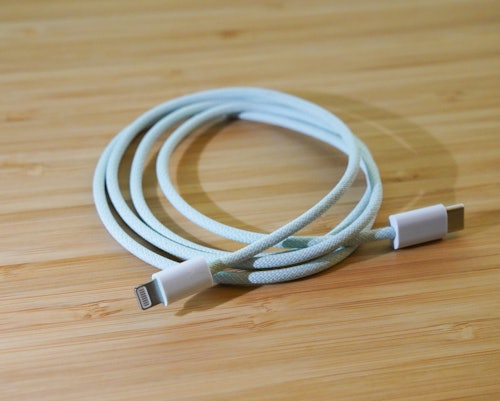After more than a decade, Apple’s iPhone 15 is putting Lightning back in the bottle as it transitions to USB-C. If you buy an this year, you’ll get something different. I’m not talking about a new titanium chassis or the non-Pro Dynamic Island.
I’m not even talking about the addition of a cross-lineup 48-megapixel camera, first-ever Action button, or 5x telephoto lens. I’m talking about something even more pivotal — something . I’m talking about Apple’s iconic, clever, and sometimes infuriating Lightning port.
Perhaps “getting” in this case is a poor choice of words. You’re actually not a Lightning port at all in the iPhone 15, you’re getting *drum roll* a USB-C. That means a lot of things for a lot of people, but I’m not here, , to talk about data transfer speeds or charging.
I’m here to say one thing: RIP Lightning. . .
well, sort of. Lightning in a box It’s been 11 years since Apple first started shoving Lightning cables into every iPhone box. Since then, a lot has changed.
While Apple went its own way with the iPhone 5, replacing its 30-pin connector for the new, 8-pin Lightning connector (and giving it a pretty cool name, I might add), just about every other phone you can buy rallied around this little thing called the Universal Serial Bus, otherwise known as USB. Over the years, USB has expanded and improved. We had USB-A and USB-B.
We had mini-USB, micro-USB, and eventually USB-C, the modern prevailing standard. And through all of that, there was but one Lightning cable. The same iconic connector I’m eulogizing today, even if it’s still used in some products.
This a eulogy, after all, so let’s start with the good stuff. Say what you will about Lightning, but when Apple introduced its iconic port, there was a lot to love. For one, it was smaller and reversible.
That means (unlike USB at the time) no matter which way the connector was facing (up or down) you could slot that sucker right into the port on your iPhone. It sounds simple, and hell, I guess it is, but in a lot of ways these are the exact quality-of-life flourishes that made Apple, . Also, context is important.
When Lightning came onto the scene, the competing technology for phones was micro-USB, which — as explained by a long-time Mac developer, — paled in comparison to Lightning for a couple of reasons, including its lack of functionality with docks. In 2012, Brockerhoff wrote : So there it is: According to Apple, Lightning was simply more convenient. End of the story.
. . except not really.
As convenient as Lightning was at the time, USB-C was released shortly thereafter and fairly quickly came to eclipse the Lightning cable in a number of key areas, including data transfer speeds and charge speeds. While Lightning still outputs a pretty measly 480 Mbps (about the equivalent to USB 2. 0) a type-C USB connector with the latest technology (we’re on USB 4.
0 now) can output a whopping 40 Gbps. At the risk of pointing out the obvious, that’s a big difference. Then there are charge times — current Lightning cables can offer up to a maximum of 25W charging while USB-C can fast charge with power as high as 240W.
Again, that’s quite a big difference. On paper and in real life, USB cables have long outpaced Lightning cables. So why are iPhone users just now getting what most would consider to be the superior technology? Well, that’s where things get icky.
Here comes the thunder Former editor, Ian Carlos Campbell, knows the pain of having too many charging cords. Apple has made some small efforts to make the case for the continued use of Lightning in its iPhones by pointing to things like added security. The company has even argued that switching would create e-waste.
The logic here is that a switch to USB-C would force people to toss their now-heaping pile of dongles in the trash, which is true albeit a little disingenuous. But if I’m putting on my detective cap for a moment, the motive for Apple’s commitment to an inferior technology also makes sense from a business perspective. Who makes money when you buy a Lighting cable? What about an adapter for said Lightning cable? And MFi licensing for third-party accessory companies? I’ll give you a hint: it ain’t Samsung.
So yes, Apple has had a major incentive to keep iPhones equipped with Lightning despite some major drawbacks. And in the end, it wasn’t clear that common sense prevailed. Optically at least, it was the European Union that sounded the death knell for Lightning.
Last year, the EU passed a (iPhone included) made after the fall of 2024 need to use USB-C. In Apple’s defense, it had already gradually begun to transition its devices, like the iPad and MacBook, for some time. Maybe that means iPhones on the way without a forceful hand from the EU.
Or maybe not. One thing is certain, however, and that’s the fact that one of Apple’s most iconic accessories (if not most iconic) is now inching toward defunct. So do what you need to do.
If you don’t plan on buying a new iPhone anytime soon, cherish (or loathe) the time you have left with your once-genius cable. If you plan on making the switch, well, maybe it’s time to wrap up your Lightning cords and put them in that rats’ nest of a box under your bed — . And no matter how you feel about the move away from Lightning, it’s hard not to feel like a switch to USB-C is the end of an era.
Maybe the iPhone 15 isn’t the iPhone of yore, and maybe that’s a good thing. .
From: inverse
URL: https://www.inverse.com/tech/apple-lightning-port-usb-c-iphone-15



